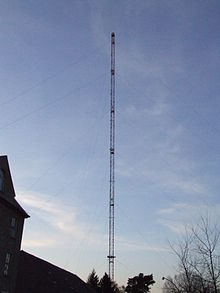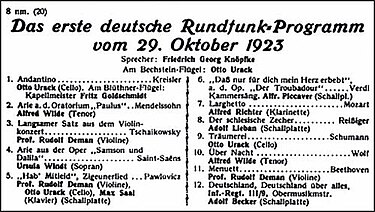Radio specter
As Funkerspuk the attempt of the revolutionary control is the radio during the November Revolution referred to the decisive consequences for a state, v. a. culturally influenced radio in the Weimar Republic.
Radio operator in World War I
The practical application of radio technology in 1894 by Guglielmo Marconi , after its discovery by Heinrich Hertz in 1886, fundamentally changed the way troops were coordinated in wars. The first radio company of the German Army was founded in 1907, and thus the Army Intelligence Unit came into being. At the beginning of the First World War , the Army Intelligence Unit took over communication between home and the individual theaters of war. Due to the heavy radio traffic during major battles, the problem arose that many radio stations interfered with one another in a confined space. This was reduced by the "plans for the frequencies to be used". As a result, during the First World War in 1917, the radio communications of the German army were restructured into an independent type of weapon called the "intelligence force". After that, the news force consisted of over 14 different groups with tasks ranging from message transmission to interception and decryption to cryptography. The increased importance of the use of radio corresponded to the fact that around 200,000 soldiers were active as radio operators towards the end of the war .
WTB is filled and the central radio management is established

On November 9, 1918, with the abdication of Wilhelm II, the monarchy of the German Empire ended and the democratic republic of Philipp Scheidemann was not only proclaimed at 2 p.m. , but also the free socialist republic of Karl Liebknecht two hours later . On the same day, the headquarters of the German press information system, Wolff's Telegraphisches Bureau (WTB), was occupied by delegates from the revolutionary Berlin workers 'and soldiers' council . Shortly thereafter, they issued an appeal that was addressed to everyone and reported to the world in the first sentence: “To everyone! Here the revolution has achieved a brilliant, almost completely bloodless victory ”. A victory that had not yet been achieved at the time.
At the same time, many war-weary radio troops also formed soldiers' councils . This created a so-called central radio line at its head, which addressed all stations of the inner-German radio network via the Berlin transmitter on the Funkerberg and demanded the organizational subordination of all systems to the central radio line. So it was intended to set up a message system that was independent of the post office.
Consequences of the radio specter
State control of broadcasting was therefore seen as necessary in the state authoritarian thinking of the conservative civil servant elite under State Secretary Hans Bredow , for fear of the possibility of widespread radicalization of the common people. It was still a matter of fending off revolutionary efforts such as the "radio specter" when the radio was introduced in 1923. The first edition of the German radio magazine Der deutsche Rundfunk cites the justification for state radio: "The most important parts of the country are occupied by the enemy, the economy is shattered, revolutionary movements threaten peace and order, and it is not yet possible to foresee when things will return to order in Germany become."
Thus, the regulation of broadcasting was more profound than just a technical limitation of the broadcasting equipment, but also included other social restrictions:
- "Radio sovereignty" of the Reich for the operation of radio reception and transmission systems (from approx. 1919)
- Prohibition of receiving radio communications with a receiver for private individuals (1922, ban repealed in 1923.)
- Introduction of the license fee of 25 gold marks (1923, from 1924 60 Reichsmarks)
- License requirement for a radio as a "radio receiving system" (1923)
When the first German radio program was broadcast on October 29, 1923, it should become clear to the few listeners what shape the new medium was, above all culturally oriented, politically conservative and absolutely loyal to the state: after about an hour of classical music, an orchestra of the Reichswehr "Germany, Germany above everything."
Brecht's radio theory
In his radio theory (written between 1927 and 1932) Bertolt Brecht explained his media theory on this then newly emerging technology, radio. For him, the radio should not only represent a representative of cultural influences, but encourage the population to change. For Brecht, however, this system was only complete when the radio was made available to citizens not only for receiving, but also for broadcasting and helping to shape it (“The radio as a communication apparatus”). With this he takes a very specific position on the nationalization of broadcasting and the missed opportunity of broadcasting “from below”.
literature
- Eva Susanne Breßler: The broadcasting industry in the Weimar Republic . In: From the experimental stage to the propaganda instrument. Böhlau Verlag, Cologne, 2009, ISBN 978-3-412-20241-5 .
- Konrad Dussel : German radio history. 2nd Edition. UVK, Konstanz 2004, ISBN 978-3-8252-2573-5 .
- Winfried B. Lerg : The broadcasting policy of the Weimar Republic. In: Hans Bausch (Ed.): Broadcasting in Germany. Volume 1. dtv 3183, Munich 1980, ISBN 3-423-03183-2 .
Web links
- Radio Chaotica: Funkerspuk (Audio)
- Martin Steyer: The Development of Broadcasting in Germany 1923–2013 (Slideshow)
Individual evidence
- ↑ Andrea Benesch: Encryption and decryption methods in the First World War . Düsseldorf 2015.
- ↑ Christoph Meinel, Harald Sack: Digital communication: networking, multimedia, security . 2009, p. 60 .
- ^ Konrad Dussel: German radio history . Constance 2004, p. 22-23 .
- ^ Alfred Hartig: The German radio system . In: The German radio . tape 1 , October 14, 1923, p. 3 .
- ↑ Hans Jürgen Koch, Hermann Glaser: Ganz Ohr: a cultural history of the radio in Germany . Böhlau Verlag, Cologne / Weimar 2005.
- ^ Bertolt Brecht: The radio as a communication apparatus . In: Collected works in 20 volumes . tape 18 . Frankfurt am Main, S. 127-134 (Large Commented Berlin and Frankfurter Edition, Volume 21, Writings 1, Frankfurt am Main 1992, pp. 552-557.).

